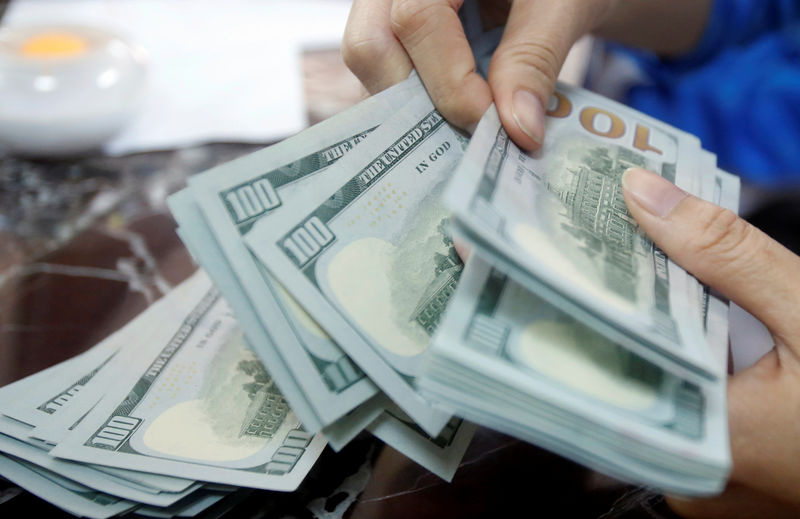 © Reuters. An employee of a bank counts US dollar notes at a branch in Hanoi
© Reuters. An employee of a bank counts US dollar notes at a branch in HanoiBy Hari Kishan
BENGALURU (Reuters) – The U.S. dollar’s rally is largely over, according to about two-thirds of currency strategists polled by Reuters who said a dialing-back of rate hike expectations has diminished the greenback’s edge over its peers.
After racking up its best performance last year since 2015, the dollar has lost momentum in recent weeks as the Federal Reserve signaled fewer interest rate hikes over the next two years and expressed caution about the U.S. economic outlook.
The Jan. 2-9 poll of 75 analysts showed the dollar is now forecast to give up most of its 2018 gains over the coming 12 months, hurt by a U.S. economy expected to lose steam as the year progresses. The gained over 4 percent last year.
“Basically the dollar has run out of things to make it go higher,” said Erik Nelson, currency strategist at Wells Fargo (NYSE:).
“The Fed has told us that they’re probably at or near a point where they’re going to pause interest rate hikes and we forecast the boost we saw to U.S. growth last year is definitely going to fade.
“Those two factors that were really supportive last year are fading. So, I don’t see what’s going to be a sort of a cyclical driver of dollar strength from here,” Nelson added.
While analysts predicting the dollar to underperform against major peers have previously been proved wrong, they are still forecasting it will reverse last year’s gains in 2019.
Thirty-nine of 62 analysts who answered an additional question said the dollar’s dominance, which started early last year, has stalled. Among those who said the currency’s run still has legs, over 85 percent said it would tire in six months at most.
Only three respondents said the dollar’s rally would continue for a year or more.
(GRAPHIC Reuters Poll: U.S. dollar’s rally now stalled? – https://tmsnrt.rs/2H0KUsH)
But medians in the poll showed other major currencies are forecast to at best recover their 2018 losses against the dollar this year.
With economic growth in other major economies expected to slow and central banks not predicted to turn hawkish anytime soon, a significant dollar slide or any prominent upside for other major currencies will be limited.
After losing about 4 percent against the dollar in 2018, the euro () was forecast to rise about 5 percent to trade at $1.20 in a year from about $1.14 on Wednesday.
While that prediction is similar to last month, the expected 12-month percentage gain in the latest survey has come down over the past few Reuters polls.
With the outlook for the euro zone economy turning bleaker after a series of data showed signs of a slowdown, the common currency was not expected to gain significantly this year.
“I acknowledge the dollar fundamentals have worsened. But I think they’ve probably worsened for the euro as well. And we might just have a sparring contest between them all year,” said Jane Foley, senior currency strategist at Rabobank, who got the dollar resurgence spot on last year.
“I don’t see a big trend in favor of one or the other being particularly dominant this year.”
Sterling’s fate, though, will be determined by how Britain’s exit from the European Union turns out. The British pound
SAFETY OR SAFETY AND HEAVENLY
While the dollar enjoyed safety-bet status last year after the U.S.-China trade war escalated, that view has faded recently and instead the yen has soared over 3 percent in a few weeks.
But the yen — the de-facto safe-haven currency — is forecast to end 2019 around where it is trading currently.
If realized, that would mark the fourth year in a row that the yen has gained against the dollar, despite a stellar 2018 for the greenback.
“While it is tempting to ignore market ‘flash crashes’ or chalk them up to technical issues, we think it is telling that ultimately settled more than 1 percent below its pre-crash level,” noted analysts at Goldman Sachs (NYSE:).
“Following rocky signals from U.S. manufacturing data, volatile equity markets and fewer Fed hikes, the drivers for JPY are all moving in sync.”
(Other stories from the global foreign exchange poll: [nL3N1Z21O7])
(Polling by Indradip Ghosh and Sarmista Sen; Editing by Ross Finley and Catherine Evans)
Source: Investing.com



























